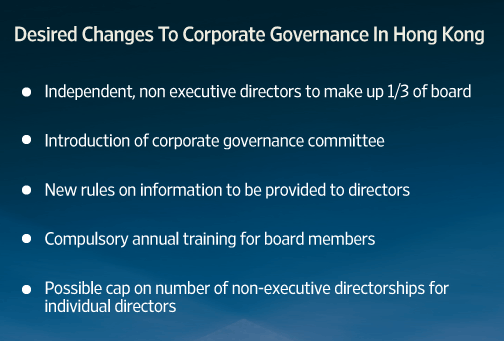HONG KONG (Dow Jones Investment Banker) – As the Stock Exchange of Hong Kong continues to attract a wide array of Chinese issuers as well as, increasingly, international companies looking to tap Asian investors, proposed changes to boardroom rules are very welcome and long overdue.
Hong Kong was the largest market in the world in terms of IPO equity funds raised in 2010, followed by Shenzhen, Shanghai, NYSE Euronext in the US and the London Stock Exchange.
The SEHK issued a consultation paper in December 2010 to further improve the governance of listed companies, following the introduction of its Code on Corporate Governance Practices in early 2005. The paper includes far-reaching changes to boardroom practice in the Special Administrative Region (SAR), where many companies are still controlled, and effectively run, by families. Responses from market participants are due 18 March.
The SEHK faced criticism in December for allowing corporate issuers incorporated in mainland China to use local accounting standards alongside Hong Kong financial reporting standards and international financial reporting standards (IFRS). It also came under fire for concluding that mainland audit firms vetted, nominated and endorsed by the central government’s ministry of finance and the China Securities Regulatory Commission (CSRC) should service these issuers.
As a result, it had to publish a lengthy eight-point rebuttal letter to defend its position, pointing to market practice in other countries and exchanges, including an announcement by the European Commission in December 2008 that mainland accounting standards, amongst others, were regarded as equivalent to IFRS as adopted by the EU.
Under the new proposals to improve corporate governance, companies listed in Hong Kong will now need at least one-third of their directors to be non-executive and independent. This compares with the current requirement, which is for the appointment of at least three independent directors, but does not specify any set ratio. The SEHK calculated that 21% of listed companies in Hong Kong do not currently meet this requirement, the introduction of which would therefore be pushed out until the end of 2012.

Although they are a welcome departure from current market practice, these proposals still fall well short of the requirements prevailing in other countries, including the US, UK and Australia, where 50% or more of directors are required to be independent and non-executive.
The SEHK has also proposed to introduce corporate governance committees, new rules for the dissemination and content of information to be provided to directors, and even suggested that all board members undergo training for eight hours annually on developments in law, regulation and other topics relevant to their duties – effectively as do members of the Hong Kong Institute of Directors and market professionals licensed to operate in Hong Kong.
The proposals also suggest that a cap may be introduced on the number of non-executive directorships that an individual may hold, although they fall short of naming what this figure might be, instead asking market participants to suggest one, if deemed appropriate.
Interestingly, some of the changes now proposed to be introduced in the SAR, such as the ratio of independent directors, were already in force on the mainland, pointing to a much needed catch-up in Hong Kong in terms of governance.
One can only hope that the changes will ultimately be endorsed.
(Philippe Espinasse worked as an investment banker in the U.S., Europe and Asia for more than 19 years and now writes and works as an independent consultant in Hong Kong. Visit his website at https://www.ipo-book.com. Readers should be aware that Philippe may own securities related to companies he writes about, may act as a consultant to companies he mentions and may know individuals cited in his articles. To comment on this column, please email [email protected]).
[This article was originally published on Dow Jones Investment Banker on 9 February 2011 and is reproduced with permission].
Copyright (c) 2011, Dow Jones & Company, Inc.
